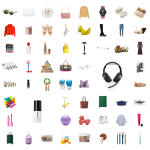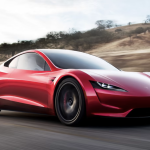
With the rise of Barbiecore and Bimbocore, the resurgence of Y2K fashion and aesthetics, and the prevalence of pink in modern activism and identity, it’s time for a phone color that meets the moment.
The 2010s were enamored with shades that whispered; the 2020s call for hues that scream. Cultural fascination with anemic millennial pinks and rose golds is dying. As the government wrenches away our bodily autonomy, and global warming threatens our existence, we are embracing the heat of hot pink.
For 2000s babies, the pink phone was the ultimate accessory. The women we idolized — Elle, Tyra, Carrie, Raven-Symoné — had them in bubblegum, sleek metallics, or adorned with rhinestones.
In 2022, hot pink is everywhere but in our hands: a vibrant Barbie shoe on the big screen, a pussy hat, and fuchsia runway couture. A potent pink accommodates both our early aughts nostalgia and the intensity of the current decade. Now we need an iPhone that accommodates them, too.
A brief history of the last 100 years of pink
Modern, ill-fated gender reveals may reify that pink is for girls and blue for boys, but the opposite was true through the early 1900s: pink was more common for boys and blue was for girls. By 1927, a TIME poll of leading U.S. clothing stores showed blue and pink as equally appropriate for either sex. For the next two decades, pops of pink appeared in womenswear, like Elsa Schiaparelli’s signature « shocking pink » in the 1930s and Christian Dior’s parfait pink in 1947, but the color remained unisex.
Pink only emerged as the calling card of femininity in the 1950s as women retreated to homemaking in post-war America. This shift was reflected in Hollywood, by Marilyn Monroe’s intense fuchsia dresses in 1953’s Niagara and Gentlemen Prefer Blondes, and most significantly, in 1957’s Funny Face. That film’s « Think Pink » musical number, sung by the editor of a fashion magazine, « made such an impact with [its] visuals of women in all things pink that our thoughts about the color were forever changed, » says Laurie Pressman, Vice President at the Pantone Color Institute.
Marketers pounced with ads that urged women to “think pink and look beautiful,” says Pressman, who leads a team tracking global color trends. Women’s cigarette brands Vogue and Vanity Fair introduced pink smokes alongside baby blue ones. Cadillac and Ford produced pink cars, while Chrysler’s Dodge LaFemme was made specifically for women in the shade « Heather Rose » and came with a pink purse, umbrella, and hat.
Barbie made her debut in 1959, dressed in a black and white striped bathing suit. The Barbie logo has been hot pink from the beginning, but it wasn’t until the 60’s that the doll began to dress in pinks, too. Barbie’s first car, a 1962 Austin Healy roadster, came in pink or brown. By the mid-1970s, pink became a staple of both Barbie’s wardrobe and lifestyle, and she adapted further in the 1980’s to reflect the decade’s obsession with neon pinks, yellows, purples, blues, and teal.
Fast forward to the arguable heyday of pink: the early 2000s, when all shades of baby, bubblegum, and fuchsia reigned. Kimora Lee Simmons founded pink-perfect Baby Phat in 1999. In 2001, Legally Blonde made pink a personality. That same year, Pantone anointed Fuchsia Rose and J.Lo wore a pink Juicy Couture tracksuit in the music video for « I’m Real, » elevating the then little-known brand that would later be worn on red carpets by Paris Hilton. Victoria’s Secret subsidiary PINK opened in 2002, the same year that Destiny’s Child bathed in the color in their Bootylicious music video. In 2004, Mean Girls weaponized pink as a hazing tool and marker of belonging for the Plastics clique (« on Wednesdays, we wear pink »).

In the last decade, pinks have softened and taken on new meaning. In 2016, Pantone named two colors of the year instead of one: Rose Quartz and Serenity — a light pink and a blue with a delicate hint of purple — as a nod to the blurring gender binary. At the same time, millennial pink and the influence of Scandinavian design transformed « slightly unsweet pastel pinks as an androgynous neutral » that « introduced a sense of calm, » says Pressman. The barely-there pink of « no-makeup » makeup brand Glossier and the pink-as-professional aesthetics of The Wing were sold to millennial and Gen Z women as lifestyle choices.
In just the last two years, hot pinks have seen a resurgence. Nostalgia for and rediscovery of Y2K style has flourished online, and women have been forced to dig their heels into their gender identity to protect their basic human rights. Helped along by the revival of pop punk, the TikTok rise of the hyper-feminine Bimbocore aesthetic, and the coining of Barbiecore, intense pink shades have been embraced everywhere except on our phones.
The history of pink phones
Pink has always suffered from what Dr. Valerie Steele, director of The Museum at FIT, has called a « terminal lack of seriousness. » In popular culture, pink has become a calling card of a particular type of mean girl — the Pink Ladies of Grease, the Plastics of Mean Girls — or a personality trait that obscures all other values — like it did for Elle Woods or Glinda of Wicked. In short, once pink was pegged as « women’s color, » it was vulgarized by misogyny.
We weren’t always begging for pink phones. The early 2000s delivered options in spades. We had pink Blackberries, Sidekicks, and even Gameboys, but Motorola . Baby Phat collaborated with Motorola on Baby Phat i833,a limited edition pillow pink flip phone accented with 0.4 carats of diamonds. Motorola’s 2005 hot pink Razr was such an iconic cultural touchstone that Casetify recently created a phone case for iPhones that imitates it.
The popularity of pink phones was also reflected on screen. Carrie Bradshaw called Mr. Big on a pink rhinestone Motorola flip, and Hannah Montana thirsted over a pink rhinestone Motorola Q. High School Musical’s Sharpay Evans clacked away on a rhinestone Sidekick. In a particularly memorable episode of Zoey 101, Zoey’s pink Tek-Mate, a fictional replica of a Sidekick II, falls into a fountain as it vibrates with a confessional text from her best friend.

Apple first dipped its toe into the pink phone pool with the iPhone 5C. Released in 2013, the 5C’s five colors included a loud coral shade that Apple called « pink. » A consumer poll found that 27 percent purchased blue, 25 percent white, 21 percent green, 20 percent coral (pink) and just seven percent yellow. Of the women that bought these colors, 33 percent bought the pink, compared to about 8 percent of men, who tended to opt for blue and white.
Those sales figures didn’t deter Apple from releasing two more yellow shades through 2019. In 2015, Apple finally unveiled a rose gold phone, but it wasn’t until May 2021 that rumors swirled that a pink iPhone 13 was finally on the way. Fan mock-ups envisioned a thrilling hot pink hue. Instead, Apple delivered a shade so light, it felt more like a suggestion of pink than the actual color.

Apple is no stranger to hot pink. As recently as 2019, they made hot pink versions of other products including two generations of the iPod touch, two generations of the iPod Mini, three generations of the iPod Shuffle, and six generations of the iPod Nano.
So why haven’t we seen an iPhone color darker than blush? Perhaps because iPhones are quite expensive. “There is still a resistance to pink on some level, which limits the market,” says Pressman. « While Barbiecore is a thing, this influence is more market specific… There just may not be enough of a consumer market that would commit to a pink shade [of iPhone]… the cost of investment coupled with the wide variations of pink makes it more difficult to choose just one and feel confident in the choice, thus a risky business proposition. » For reds and blues « variation may be less material to the sale of the phone, » she says, while green recalls nature and purple is not as gendered.
But the iPhone is a gendered product because it’s purchased more by women than by men. Why release more yellow iPhones — a color liked by neither gender — and not more pink ones?
Plus, the argument about the price difference between Androids and the more expensive iPhone doesn’t quite hold up. In early 2020, for example, Samsung offered an absolutely delicious bubblegum pink with a holographic sheen for its Galaxy 5G S20. That phone ran for $999. Its rival, 2019’s iPhone 11, started at $699.
Apple may have some very smart people crunching the numbers, but something doesn’t quite add up.
The case for a pink iPhone
Ultimately, « color is a language we use to express, » Pressman says, and « the popularity of certain colors and color families reflect what is taking place in the culture. » And if ever there was a time to revive the hot pink phone, it would be in the next year.
« At the Pantone Color Institute, we always talk about how films in production influence trends in color, » says Pressman. « The Barbie movie is not set to be released until 2023 and already it has permeated design. » Most significantly, Valentino has united their brand under a newly minted house color, PP Pink, a searing, scintillating shade that embodies both the vibrance of Barbie and the attitude of Bimbocore.

A similar shade — the bright, spirited « protest pink » — is now synonymous with 21st century activism. It has been attendant at the growth of the #MeToo movement and in the fight for reproductive rights, seen in pussy hats that marched on Washington in 2017, the protests of CODE PINK, and in recent campaigns by Planned Parenthood.
The hot pink worn by protestors, bimbos, Barbie, and Valentino models alike « totally meets the moment, » Pressman says. The color fulfills « our desire for unabashed personal expression and our pent up desire to just have some fun after having our lifestyle curtailed these past few years due to Covid. »
Hot pink also reaches inside us to rouse the soft, safe feelings that cast a glistening sheen over nostalgic hindsight. We glimpse the unspoiled girlishness of our youth and bask the uncomplicated joys of its rosy glow. Pink is a core part of our identity; forever affiliated with the fictional women we wanted to be like and the styles we wore as we found ourselves. Our phones are an extension of us. We should be able to buy one in a color that feels true to who we are.





